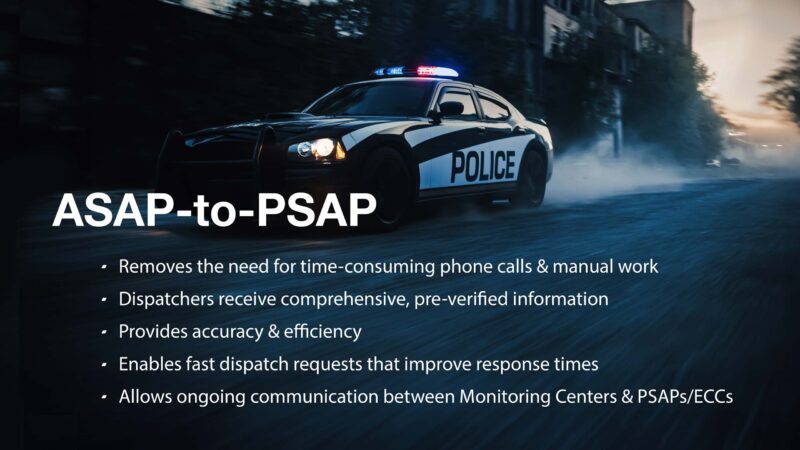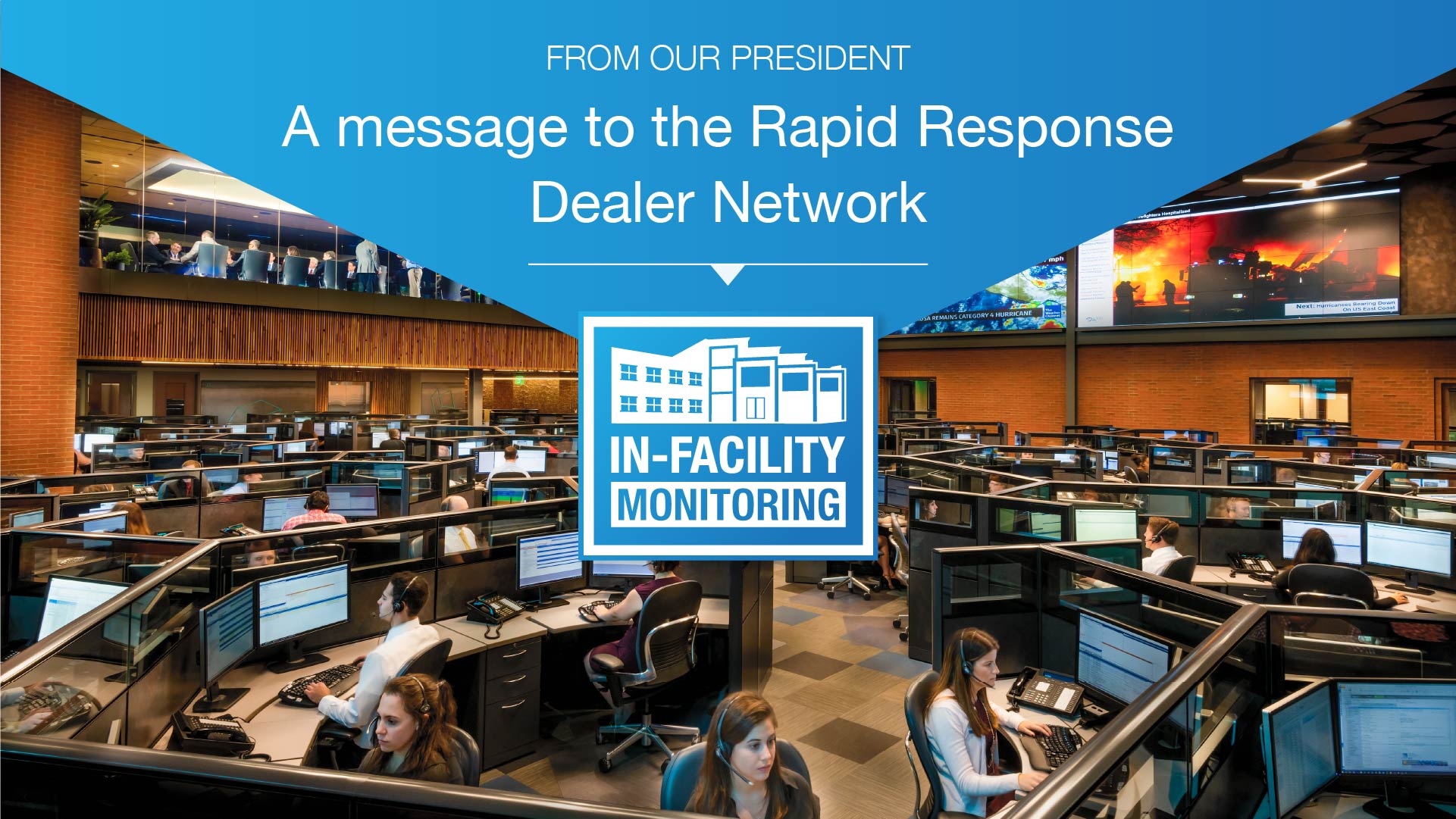In the realm of emergency response, every second counts. The ability to swiftly and accurately relay critical information from our Monitoring Centers to PSAP/ECCs (Public Safety Answering Point/Emergency Communication Centers) can make a monumental difference in saving lives and protecting communities.
This is where the ASAP-to-PSAP integration steps in. ASAP-to-PSAP stands for Alarm Service Automation Protocol to Public Safety Answering Point. Its integration into monitoring centers and PSAPs/ECCs has been a transformative solution designed to streamline communication, therefore enhancing the efficiency and effectiveness of emergency services.
How It Works and Its Origins
In the event of an alarm, our Monitoring Center Specialists promptly receive an emergency signal. The Specialists gather crucial details and follow Emergency Call Verification (ECV) and/or dispatch procedures. In the event of needing an emergency response, the Specialist can request it through the simple click of a button. This streamlined process ensures a rapid and effective response.
The origins of this program can be traced back to Bill Hobgood, a distinguished professional with an extensive emergency services and public safety background. Through his leadership as the primary The Monitoring Association (TMA) contractor, he has played a crucial role in driving the adoption of this solution across various public safety answering points, and remains dedicated to pushing the boundaries of technology.
With a wealth of experience as a former PSAP/ECC dispatcher and administrator, and a unique perspective into the challenges they face, Bill’s contributions have revolutionized the industry.
One of the most notable advantages of ASAP-to-PSAP is its ability to significantly reduce errors and miscommunication during critical moments. Traditionally, the transfer of alarm-related data relied heavily on manual processes, which introduced the possibility of transcription errors, delays, and missed details. ASAP-to-PSAP automates this information exchange, ensuring vital data is accurately transmitted.
When a Specialist sends a dispatch request through ASAP-to-PSAP, the PSAP/ECC dispatcher instantly receives the pre-verified information below:
- Site name
- Site address
- Site type (residential/commercial)
- Alarm type (audible/silent)
- Permit(s)
- Area & zone description
- Cross streets
- Directions
- Monitoring center name
- Monitoring center phone number
- Service company name (Dealer’s name)
- Service company phone number (Dealer’s main phone)
- Premise phone number
- Our AlarmNum (event ID in our system)
The Specialist waits for up to one minute to receive acceptance or rejection. If rejected, they are prompted to call the PSAP/ECC to relay the alarm information as we traditionally would have. Once accepted, the Specialist proceeds with any other actions that the action plan specifies. We can and will continue to communicate with the PSAP using ASAP as needed, whether additional information was requested or gathered by us, up until the PSAP/ECC closes the alarm in their CAD system.
It is important to note that aside from the initial investment to upgrade the CAD architecture to support ASAP, there is no cost to PSAPs/ECCs to support ASAP-to-PSAP.
Jurisdictional Activations of ASAP-to-PSAP
At Rapid Response, our workflows incorporate logic to determine if the target PSAP is ASAP-capable. If so, the account address data is validated by the PSAP/ECC’s CAD system. Once completed and tested, our Specialists will be presented with dispatch action plans via ASAP-to-PSAP for any Dealer with accounts in the jurisdiction that was integrated.
Derek Aldrich, our lead System Manager for ASAP-to-PSAP integrations, with over 20 years of experience at Rapid Response, shared, “ASAP-to-PSAP has revolutionized our workflows at Rapid Response. With the ability to seamlessly collaborate with ASAP-capable PSAPs/ECCs, our Specialists execute dispatch action plans with a simple click. This technology empowers us to provide swift and efficient emergency response.”
Current Limitations and Future Developments
Currently, the implementation of ASAP-to-PSAP for GPS accounts is not feasible due to limitations in certain PSAP/ECC’s CAD systems. However, the next version of ASAP-to-PSAP may include this capability. Additionally, TMA is exploring the possibility of incorporating additional functionalities, including the ability to share URLs. This would be a significant enhancement that would allow for sharing video footage.
Our Commitment to ASAP-to-PSAP
Our commitment to ASAP-to-PSAP has yielded remarkable results for our customers, driving us to add jurisdictions as soon as they join the program. The adoption rate of ASAP-to-PSAP is steadily increasing, with TMA aiming for 80% of the country’s PSAPs/ECCs to be online with the program by 2028.
Through our commitment to this program, we are driving a positive change in public safety, ensuring timely and accurate response to emergencies.
Looking ahead, we are excited to witness the continued growth and success of ASAP-to-PSAP across the country. By fostering collaboration and innovation, we are working towards a future where the majority of PSAPs/ECCs are connected, improving emergency response nationwide and ultimately saving more lives.
As an active participant in the ASAP-to-PSAP program, we are proud to have 130+ jurisdictions on our roster, listed below, benefiting from this integration (up to date as of July 2023).
Crawford County, PA | Owensboro/ Daviess County, KY | Cumberland County, PA | Charlotte County, FL | Newport News, VA |
Bell County, TX | Hendricks County, IN | Paradise Valley, AZ | Burleson, TX | Monroe County, NY |
Seattle, WA | Lawrence, IN | Cayuga County, NY | Virgina Beach, VA | Dane County, WI |
El Paso County, CO | Hartsfield-Jackson Atlanta Airport, GA | Murfreesboro, TN | Bradley County, TN | Manatee County, FL |
Henry County, GA | Atlanta, GA | Martinsville/ Henry County, VA | Roanoke, VA | Bucks County, PA |
Fairfax County, VA | Elk County, PA | Saint Paul/Ramsey County, MN | Boone County, MO | Wilson County, NC |
Deschutes County, OR | Colonial Heights, VA | Ontario County, NY | Williamson County, TN | Highland Park, TX |
Genesee County, NY | Valley Communications/King County, WA | Raliegh/Wake County, NC | Dauphin County, PA | Johnston County, NC |
New River Valley/ Montgomery County, VA | Talladega, AL | Jefferson County, CO | Montgomery, AL | High Point, NC |
Snohomish County, WA | Thurston County, WA | Galveston County, TX | Plano, TX | Delaware County, OH |
Sound 911/ Pierce County, WA | Charlottesville/Albermarle County, VA | Harrisonburg/ Rockingham County, VA | Little Rock, AR | Durham, NC |
Riverside, CA | Kitsap County, WA | Westerville, OH | Chesapeake, VA | Kernersville, NC |
Portland/ Multnomah County, OR | Chesterfield County, VA | Onondaga County, NY | Dublin, OH | Grand Prairie, TX |
Leesburg, VA | Chesterfield County, VA | Dekalb County, GA | Alpharetta, GA | Guilford County, NC |
Calvert County, MD | Beaumont, TX | Arlington County, VA | Chester County, PA | Boca Raton, FL |
Baltimore, MD | Pasco County, FL | Memphis, TN | Riviera Beach, FL | Morgan County, AL |
Kenosha County, WI | Mecklenburg County, VA | Nashville/ Davidson County, TN | Prince Georges County, MD | Cary, NC |
Irving, TX | Prince William County, VA | Cincinnati, OH | Brentwood, TN | Chandler, AZ |
Fort Worth, TX | Iredell County, NC | West Palm Beach, FL | Collier County, FL | Denton County, TX |
New Hanover County, NC | Volusia County, FL | Hanover County, VA | Phoenix, AZ | Henrico County, VA |
Rockwall, TX | Tuscon, AZ | Augusta/ Richmond County, GA | Missouri City, TX | James City County, VA |
Licking County, OH | Portsmouth, VA | Fayetteville/ Cumberland County, NC | Monroeville, PA | York-Poquoson-Williamsburg Regional 911 Center |
Oneida County, NY | Harris County, TX | Broome County, NY | Sarasota County, FL | Tempe, AZ |
Rice & Steele Counties, MN | Indianapolis/ Marion County, IN | Powhatan, VA | Hamilton County, TN | Washington, DC |
Dakota County, MN | Anoka County, MN | Bradenton, FL | Loudoun County, VA | Houston, TX |
Denver, CO | Suffolk County, NY | Hamilton County, OH | Union County, NC | Richmond, VA |
Queen Annes County, MD |
To learn more about ASAP-to-PSAP, visit tma.us or reach out to us for more information.






